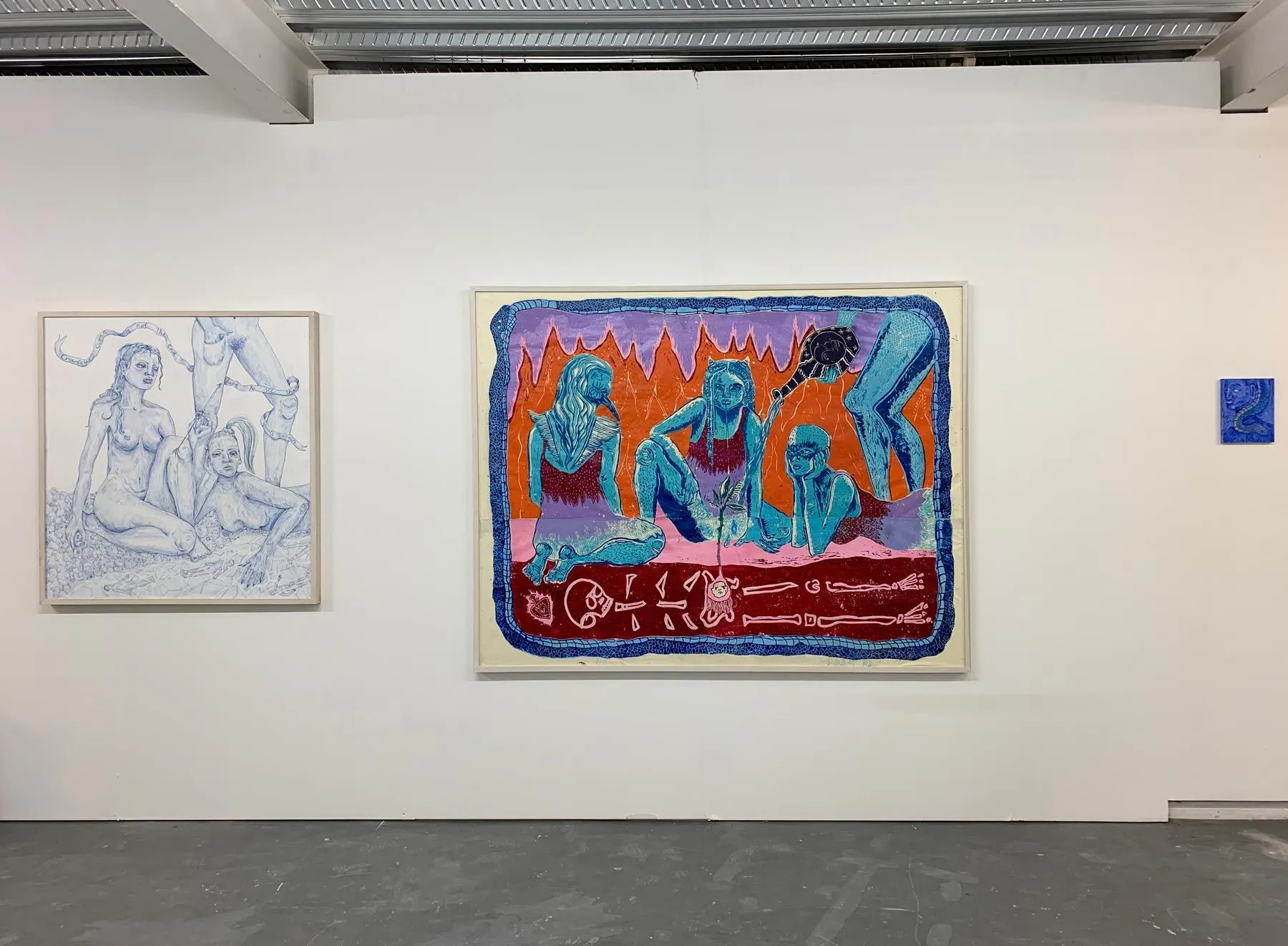The Old World Is Burning
The burning world the title refers to can be seen as a reference to our current political and ecological climate. There is a climate crisis happening in the world right now, and there is simply not enough being done to save our planet. The bright orange flames engulf the background of the piece in a seemingly destructive manner - ‘The old world is burning’. However, all living things are in some way fertilized, tempered, ripened or destroyed by forms of fire and the universe described in the piece is no different, there is hope for a new life after the fire.

Handprinted Linocut, Ink on Japanese Paper, 200 x 145 cm
‘Now Is The Time Of Monsters’ refers to both the political landscape and the almost biblical challenges humanity faces in this time of ecological collapse, but the four giant figures can also be viewed as monstrous. In the image we see four giant blue nymphs. A nymph is a being from Greek mythology. Nymphs are more generally regarded as divine spirits who animate or maintain nature for the environments where they live, and are usually depicted as beautiful, young, graceful maidens. Here, Marshall has depicted them instead of light and graceful as fierce and bold and almost intimidating or ‘monstrous’ with bright blue ink. They crowd around in wonder at a singular plant emerging from the ground, almost like cavemen looking at the discovery of fire. One figure pours water on it from a vase decorated with both the sun and moon, one of the many references to time, rebirth and nature within the work.
Each figure or nymph represents a different element of nature.
The figure with the wings and beak is air or the sky. The central figure with horns is a representation of earth, with her small horns being a nod the many cow mother goddess throughout history, such as the Egyptian cow goddesses Nut, Hathor and Isis. In many cultures, animal symbolism of the cow is married to the concept of Mother Earth, and has been a symbol of fertility, nurturing, and power for centuries. The figure with the ashen face is fire and the figure seen pouring the vase with scales on her legs is water. References to the four elements can be found in much of Marshalls practice.
The idea of planting seeds in the ashes and singing over the bones is hope for renewal in our current times.
Through the agency of fire, flesh, bones and other matter turns to ash, it is all that remains. In ash there is finality, that which has been extinguished. But also it has always been associated with the scared and essential. Folk customs and religious rites express the symbol of ash as a fertilizer of physical and psychic earth, which as we can see by the seed in the image, fosters the emergence of new matter and gives rise to rebirth.
The sowing of the seed evokes every form of procreation. In the print, the seed is seen coming from where the womb would be in the skeleton, another reference to rebirth and the cyclical nature of life and death.
Another image representing the cyclical nature of time is the ouroboros(snake eating its tail) which frames the entire piece. The Ouroboros is a Greek word meaning "tail devourer," and is one of the oldest mystical symbols in the world. It can be perceived as enveloping itself, where the past (the tail) appears to disappear but really moves into an inner domain or reality, vanishing from view but still existing.
The ouroboros has several meanings interwoven into it. Foremost is the symbolism of the serpent biting, devouring, or eating its own tail. This symbolizes the cyclic nature of the universe: creation out of destruction, life out of death.

Exhibition view

Exhibition view

Exhibition view
Exhibited at
Cursebreakers,
September 2021
—
January 2022
De La Warr Pavilion
|
Bexhill, East Sussex
Outside The Line,
February 2022
—
April 2022
Sara Zanin Gallery
|
Rome, Italy